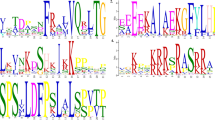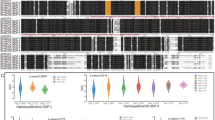Abstract
An S4-allele-associated protein (S4-protein) was identified by both isoelectricfocusing (IEF) polyacrylamide-gel electrophoresis and N-terminal amino-acid sequences in self-incompatible Nijisseiki (self-in- compatibility genotype=S2S4) and self-compatible Osa-Nijisseiki (S2S4 SM, SM=stylar-part mutant) styles of the Japanese pear, Pyrus serotina Rehd. var. culta Rehd. Expression of the protein in the cultivars was compared during flower bud development and at post-transcriptional levels.
In mature styles, S4-protein could be detected on IEF gel in both cultivars and the N-terminal amino acid sequences were identical, although Osa-Nijisseiki contained only one-third the amount contained in Nijisseiki. No difference was observed in S2-protien amounts. In Nijisseiki styles, S4-protein was already detectable 8 days before anthesis (DBA) and it was synthesized consistently until 2 days after anthesis (DAA); the amount increased 4.7-fold during these 10 days. In contrast, S4-protein in Osa-Nijisseiki was not detected earlier than 6 DBA; a small amount was found at 4 DBA, and it increased gradually as flowers developed. Thus, expression of Osa-Nijisseiki S4-protein is developmentally controlled in the same way as that of Nijisseiki S4-protein, but with a time lag of several days; the protein level at 2 DAA corresponded to that of Nijisseiki earlier than 4 DBA. S4-proteins from both Nijisseiki and Osa- Nijisseiki showed RNase activity and the activity was also developmentally controlled; it increased about fourfold during the interval from 8 DBA to 2 DAA in Nijisseiki, and 3.3-fold during the interval from 4 DBA to 2 DAA in Osa-Nijisseiki. Activity at 2 DAA, however, was twice as high in Nijisseiki. In vitro protein synthesis showed that poly(A)+ from mature Osa-Nijisseiki styles could form S4-like protein in a manner similar to that of Nijisseiki. These results suggest that the self-compatibility of Osa-Nijisseiki is due to a low level of S4-protein expression, a mechanism very similar to the low level of S-protein and weak incompatibility in immature styles of self-incompatible Nijisseiki. Part of this protein repression may be regulated during post-transcriptional events.
Similar content being viewed by others
Author information
Authors and Affiliations
Additional information
Received: 10 March 1998 / Revision accepted. 22 February 1999
Rights and permissions
About this article
Cite this article
Hiratsuka, S., Nakashima, M., Kamasaki, K. et al. Comparison of an S-protein expression between self-compatible and -incompatible Japanese pear cultivars. Sex Plant Reprod 12, 88–93 (1999). https://doi.org/10.1007/s004970050176
Issue Date:
DOI: https://doi.org/10.1007/s004970050176




